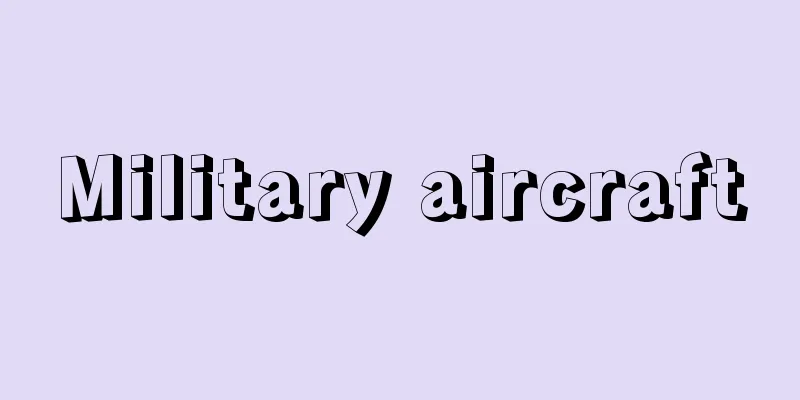Military aircraft

|
Abbreviation for military aircraft, it refers to aircraft used by the military for military purposes. The first time the air was used for military purposes was in 1794, when the French Army used a balloon to scout the enemy's situation, which was the beginning of military aviation. When the Wright Brothers succeeded in powered flight in 1903, the US Army became interested in it, and in 1907, the world's first military aircraft was ordered and equipped, and military applications were considered from the early stages of aircraft's creation. World War I was the first time that aircraft were used in war in earnest, and in the following World War II, various types of military aircraft were made according to the purpose, and military aircraft were specialized into fighters, reconnaissance aircraft, heavy bombers, light bombers, attack aircraft, patrol aircraft, direct support and liaison aircraft, transport aircraft, training aircraft, naval carrier-based attack aircraft, torpedo bombers, and flying boats. These military aircraft had capabilities incomparable to those of World War I, and came to determine the outcome of the war. The development of military aircraft continued after World War II, and with the advent of jet aircraft in particular, a new era began, with more flexibility in uses and fewer types of aircraft. Here, we will describe military aircraft after World War II, categorizing them into major categories. The main types include fighters, attack aircraft, bombers, reconnaissance aircraft, anti-submarine patrol aircraft, electronic warfare aircraft, command and liaison aircraft, transport aircraft, trainers, and helicopters, and are used by the military forces of countries around the world. Fighter aircraft are primarily intended for air-to-air combat, and therefore must be equipped with speed, acceleration, climbing ability, and maneuverability, and must be equipped with weapons that overwhelm enemy fighters. For this reason, the aircraft are made small and lightweight, and are equipped with high-performance radar and air-to-air missiles. Stealth, which makes it difficult for the enemy to detect it, will also be an essential characteristic for future fighter aircraft. The latest fighter aircraft have the ability to detect and destroy enemies first, delaying their detection by the enemy and detecting them first, and have super maneuverability that allows them to surpass their opponents even in dogfights. The ability to simultaneously attack multiple targets individually with missiles has also become commonplace. Attack aircraft are used for air-to-ground and air-to-ship attacks, but with the increasing performance of engines and the multi-function of radars, there are an increasing number of fighter aircraft that can be converted into attack aircraft simply by equipping them with attack weapons. For this reason, it is difficult to clearly distinguish between the two, but there are still attack-only aircraft that are not equipped with air-to-air weapons. Examples include stealth aircraft, which use their stealthiness to make them difficult to detect and carry out pinpoint attacks, close-quarters support aircraft, and anti-tank attack aircraft. The number of bombers is gradually decreasing, and only the United States, Russia, and China have bomber forces in the true sense of the word. One reason is that the armament load of fighter and attack aircraft has increased, and they can carry bombs of the same size as medium bombers after World War II. In addition, the main strategic weapons have become nuclear weapons, and various missiles have been developed as a means of transporting them, which has reduced the significance of manned strategic bombers. Strategic attacks by bombers carry the risk of invading enemy territory, and maintaining their military power in peacetime requires much greater expenses than missiles. However, the power of humans with excellent judgment is flexible enough to respond to changes in the situation, and they can be highly reliable, and unlike missiles, they can be turned back at any time and can be reused, so they remain one of the pillars of strategic attacks. Furthermore, the practical application of cruise missiles has expanded the scope of use of bombers. This type of model will not increase in the future, but it is also difficult to imagine it disappearing. Reconnaissance aircraft are aircraft designed to investigate enemy situations, but like bombers, they also carry the risk of entering enemy territory. With the advancement of reconnaissance satellites, their role is being replaced by satellites. Reconnaissance satellites have come to dominate the photography for intelligence gathering, and traditional reconnaissance aircraft have almost disappeared from the U.S. Air Force. However, reconnaissance aircraft are more flexible in terms of obtaining the necessary information when needed, and since many countries do not possess reconnaissance satellites, they are still used in many countries. In addition to photography, videography and electronic reconnaissance methods have been developed for reconnaissance, and special data links have also been created to send information to ground command centers in real time. In recent years, unmanned aerial vehicles (UAVs) are becoming the norm. Anti-submarine patrol aircraft are aircraft designed to detect and find submarines, and to attack them if necessary. Previously, submarines were a threat to naval fleets and transport convoys, but as they became equipped with submarine-launched ballistic missiles, they became a major strategic threat. When submerged underwater, they are difficult to detect by visual or optical means, and can approach strategic bases and launch reliable nuclear attacks. For this reason, the ability to detect submarines using anti-submarine patrol aircraft has become increasingly important, and their development continues. Electronic warfare aircraft support attacking forces by disrupting and disrupting enemy radar and other detection methods. Currently, military detection methods are mainly electronic equipment, and jamming and counter-jamming technology are becoming more advanced every year. Airborne Early Warning and Control (AEW) aircraft and Airborne Early Warning and Control (AWACS) aircraft are a type of electronic warfare aircraft. These can be considered airborne radar sites, and can detect low-altitude flying targets that are difficult to detect with ground-based radar, as well as small targets such as cruise missiles, and support interception activities. Command and liaison aircraft are used for command and control from the air, or for communication between operational areas and bases, and small transport aircraft are mainly used for the latter. A representative example of the former is the American Advanced National Command Post (AABNCP), which is capable of waiting in the air with the president and senior staff on board in the event of a crisis such as a nuclear attack, and sending all orders, including nuclear attacks, to the entire military. Transport aircraft transport personnel, supplies, and materials by air, and are essential for establishing and maintaining combat power in combat zones. A special type of transport aircraft is the aerial refueling tanker, which refuels in mid-air. The training aircraft trains flight crew members. Helicopters have undergone particularly remarkable development. Originally used only for transporting small numbers of personnel and for observation and surveillance, they have become larger and equipped with weapons, and various specialized aircraft compatible with fixed-wing aircraft are now in use, including attack helicopters, transport helicopters, anti-submarine helicopters, reconnaissance and search helicopters, and electronic warfare helicopters. In particular, in terms of reconnaissance and attack, helicopters can fly just above the ground, allowing them to approach targets undetected. For reconnaissance, optical equipment is installed on the rotor mast, and equipment has also been created that can search for targets while hidden in the shade of trees. [Kenichi Aoki] "Aviation Journal Special Edition: Military Aircraft of the World 1985" (1984, Aviation Journal Co., Ltd.) [References] | | | | |Japan Air Self-Defense Force fighter F-15J Eagle. Overall length 19.4m, overall width 13.1m, total weight approximately 25t, maximum speed approximately Mach 2.5, maximum range approximately 4600km. 1 x 20mm machine gun, 4 x air-to-air radar missiles, 4 x air-to-air infrared missiles ©Shogakukan "> F-15 fighter An anti-submarine patrol aircraft of the Japan Maritime Self-Defense Force. Overall length 35.6m, overall width 30.4m, takeoff weight 56t, maximum speed approximately 732km/h ©Shogakukan "> Patrol aircraft P-3C A combat helicopter of the Japan Ground Self-Defense Force. Overall length 17.73m, main rotor diameter 14.63m, maximum weight 10.4t, maximum speed 270km/h, crew of 2. Air-to-air missiles, 70mm rockets, Hellfire missiles, 30mm cannon ©Shogakukan "> Combat helicopter AH-64D A transport helicopter of the Japan Ground Self-Defense Force. Overall length 30.18m, main rotor diameter 18.29m, maximum gross weight 22.68t, maximum speed 280km/h. Crew 3 + 55 persons ©Shogakukan "> Transport helicopter CH-47J A patrol helicopter of the Japan Maritime Self-Defense Force. Overall length 19.8m, rotor diameter 16.4m, maximum speed approximately 257km/h ©Shogakukan "> Patrol helicopter SH-60K Source: Shogakukan Encyclopedia Nipponica About Encyclopedia Nipponica Information | Legend |
|
軍用航空機の略で、軍事上の目的で軍により使用される航空機のこと。空中を初めて軍事目的で使用したのは、1794年にフランス陸軍が気球で敵の情勢を偵察したときで、これが軍事航空の端緒であった。1903年にライト兄弟が動力飛行に成功すると、アメリカ陸軍がそれに関心を寄せて1907年に世界で初めて、軍用航空機としての発注・装備が行われるなど、航空機はその誕生の初期から軍事目的への応用が考えられた。本格的に戦争で使われたのは、第一次世界大戦が初めてで、続く第二次世界大戦では用途に応じたさまざまな種類の軍用機がつくられて、戦闘機、偵察機、重爆撃機、軽爆撃機、襲撃機、哨戒機(しょうかいき)、直協・連絡機、輸送機、練習機、海軍の艦載攻撃機、雷撃機、飛行艇など、軍用機の専門分化が行われた。そしてこれらの軍用機は、第一次世界大戦当時とは比較にならないほどの能力を有して、勝敗の帰趨(きすう)を決める存在となっていった。 軍用機の開発は第二次世界大戦後も続けられ、とくにジェット機の実用化によって新しい時代に入るとともに、用途の柔軟性を増して、種別の面では減ることとなった。ここでは、第二次世界大戦後の軍用機について、大きな種類分けに沿って記しておく。おもな種類としては、戦闘機、攻撃機、爆撃機、偵察機、対潜哨戒機、電子戦機、指揮・連絡機、輸送機、練習機、ヘリコプターがあって、世界各国の軍で使用されている。 戦闘機は、空対空戦闘を主任務とするもので、速度・加速性能、上昇力、機動性に優れ、敵戦闘機を圧倒する武装を備えていることが必要になる。このため機体は小型・軽量につくられ、他方高性能のレーダーと空対空ミサイルなどを搭載する。また敵に発見されにくくするステルス性も、これからの戦闘機では必要不可欠な特性となる。最新の戦闘機では、敵による発見を遅らせ、先に敵を発見する「先制発見・先制撃破」と、格闘戦闘に入っても相手を凌(しの)ぐ超機動性を有する。複数の目標に対し、個別に同時ミサイル攻撃を行う多目標同時処理能力も、現在では常識化している。攻撃機は、空対地、空対艦の攻撃に使われるものだが、エンジンの高性能化とレーダーなどの多機能化によって、戦闘機に攻撃用兵装を搭載するだけで攻撃機に転用できるようにした機体が増えている。このため、両者の明確な区分けはむずかしくなっているが、空対空兵装を装備しない攻撃専用機も残っている。発見されにくくした隠密(おんみつ)性を活かしてピンポイント攻撃を行うステルス機や、近接支援機、対戦車攻撃機などがその代表である。 爆撃機は、しだいに数が減ってきており、本来の意味での爆撃機部隊を有しているのはアメリカ、ロシア、中国程度になっている。理由の一つは、戦闘・攻撃機の兵装搭載量が増加し、第二次世界大戦後の中爆撃機程度の爆弾類を搭載できるようになったことがあげられる。また、戦略兵器の主体が核兵器となり、その運搬手段として各種のミサイルが開発されたことも、有人戦略爆撃機の存在意義を低下させた。爆撃機による戦略攻撃は、敵地に侵入するというリスクがあり、また平時にその戦力を維持するにはミサイルよりもはるかに膨大な経費を必要とする。しかし、優れた判断力をもつ人間の力が、状況の変化に応じうる柔軟性に富み、高い信頼性を発揮できることと、ミサイルと違っていつでも引返しが可能で、かつ再使用できるという利点を有しており、戦略攻撃の柱の一つであり続けている。さらに巡航ミサイルの実用化により、爆撃機の使用範囲も広がった。今後、この機種が増加することはないが、なくなることもまた考えにくい。 偵察機は、敵の情勢などを探るための機種だが、これも爆撃機同様、敵地に入り込むというリスクを抱えている。そして偵察衛星の進歩により、その役割は衛星に切り替えられつつある。情報収集のための写真撮影は、偵察衛星が主体となってきており、従来のタイプの偵察機は、アメリカ空軍からはほとんど姿を消した。しかし、必要なときに必要な情報を得るという点では、偵察機の運用のほうが柔軟性に富み、また偵察衛星を保有していない国も多いから、まだ多くの国で活用されている。偵察方式も、写真撮影以外にビデオ撮影や、電子偵察手段が開発され、さらにその情報をリアルタイムで地上の指揮所に送る、特別なデータリンクもつくられている。近年ではさらに、無人航空機(UAV)が主体になりつつある。 対潜哨戒機は、潜水艦の探知・発見と、必要に応じて潜水艦攻撃を行うための機種である。以前は、潜水艦は海軍の船団や輸送船団の脅威であったが、潜水艦発射弾道ミサイルを装備するようになると、大きな戦略脅威となった。海中に潜行すれば、目視や光学手段では探知が困難で、戦略拠点に接近して確実な核攻撃を行うことが可能になっている。それだけに対潜哨戒機による潜水艦の探知は重要なものとなり、発達が続いている。 電子戦機は、敵のレーダーなどの探知手段を妨害・攪乱(かくらん)して、攻撃部隊などを支援するものである。軍用の探知手段が電子装備を主体としている現在、これに対する妨害と、それに対する対妨害技術は、年々高度化している。電子戦機に準ずるものの一種として、早期警戒機(AEW)や空中早期警戒管制機(AWACS)がある。これらは空中のレーダー・サイトといえるもので、地上のレーダーでは発見しにくい低空飛行目標や、巡航ミサイルなどの小型目標を早期に探知し、要撃活動を支援する。 指揮・連絡機は、空中からの指揮・統制、あるいは作戦地域間や基地間の連絡を行うもので、後者には小型の輸送機がおもに使われている。前者では、アメリカの発達型国家空中指揮所(AABNCP)が代表的存在で、核攻撃を受けるなどの危機が発生した場合、大統領や上級幕僚を乗せて空中に待機し、核攻撃を含むあらゆる指令を全軍に送る機能を有している。 輸送機は、人員や物資、資材の空輸を行うもので、戦闘地域での戦力の確立や、それを維持するための補給には不可欠な存在である。輸送機の特殊な型としては、空中で燃料を補給する空中給油機がある。 練習機は、航空乗員の養成を行う。 ヘリコプターは、とくに発達の著しい機種で、元々は少数の人員輸送や観測・監視にのみ使われていたが、大型化や武装の携行能力などを有するようになり、攻撃ヘリコプター、輸送ヘリコプター、対潜ヘリコプター、偵察・索敵ヘリコプター、電子戦ヘリコプターなど、固定翼航空機に対応した各種の専用機が使用されている。とくに索敵・攻撃の面では、地表すれすれを匍匐(ほふく)飛行することが可能で、探知されずに目標に接近することができる。索敵では、ローター・マスト上に光学機材などを装備し、木陰に隠れたまま目標を探すための機材もつくられている。 [青木謙知] 『『航空ジャーナル別冊 世界の軍用機1985』(1984・航空ジャーナル社)』 [参照項目] | | | | |航空自衛隊の戦闘機F-15Jイーグル。全長19.4m、全幅13.1m、全備重量約25t、最大速度マッハ約2.5、最大航続距離約4600km。20mm機関砲×1、空対空レーダーミサイル×4、空対空赤外線ミサイル×4©Shogakukan"> 戦闘機F-15 海上自衛隊の対潜哨戒機。全長35.6m、全幅30.4m、離陸重量56t、最大速度約732km/h©Shogakukan"> 哨戒機P-3C 陸上自衛隊の戦闘ヘリコプター。全長17.73m、主回転翼直径14.63m、最大全備重量10.4t、最大速度270km/h、乗員2名。空対空ミサイル、70mmロケット弾、ヘルファイアミサイル、30mm機関砲©Shogakukan"> 戦闘ヘリコプターAH-64D 陸上自衛隊の輸送ヘリコプター。全長30.18m、主回転翼直径18.29m、最大全備重量22.68t、最高速度280km/h。乗員3+55名©Shogakukan"> 輸送ヘリコプターCH-47J 海上自衛隊の哨戒ヘリコプター。全長19.8m、回転翼直径16.4m、最大速度約257km/h©Shogakukan"> 哨戒ヘリコプターSH-60K 出典 小学館 日本大百科全書(ニッポニカ)日本大百科全書(ニッポニカ)について 情報 | 凡例 |
Recommend
Educational welfare work staff training institute
...Reformatory schools are the successors of refo...
Illustrated Sutra of Cause and Effect
This is a pictorial explanation of the "Kako...
Mauricio Raúl Kagel
1931‐ A composer born in Argentina. He is also kno...
Gi (Japan) - Gi
…In the application of the Japanese Code, there a...
Kakusuke - Kakujo
Year of death: 1.10 of the Shoryaku era (1077) Yea...
Helotium citrinum (English spelling) Helotiumcitrinum
…Representative species include the bright yellow...
Wei (English spelling)
A Chinese official title. In charge of military af...
Prince Kuniyoshi
Year of death: March 20, 1326 (April 23, 1326) Yea...
Act of opening of facility - Opening of facility
… After the actual existence of a road is establi...
Pseudis paradoxa (English spelling)
For example, the English name of the European tre...
Event (geomagnetic) - Event
...they are broadly divided into two periods (fir...
Kimura Ihei
Photographer. Born in Shitaya, Tokyo. A master of...
Eastern White Pine
... P . armandii Planch.var. amamiana (Koidz.) Ha...
Gangi ladder - Gangibashigo
〘noun〙 A ladder made from a single thick piece of ...
Pablo, L.de (English spelling) PabloLde
...This flourishing period, called the "New ...

![Oita [city] - Oita](/upload/images/67cb1374c2a3d.webp)







